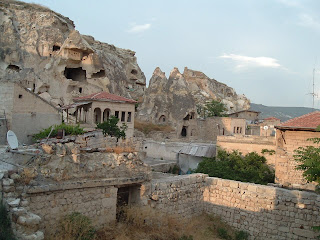In our case, we had expected Akemi’s arrival Wednesday morning, but due to a last minute flight cancellation at Dulles on Tuesday, her travel plans were unavoidably altered. Even with the changes and delays she encountered during her journey, she managed to arrive Istanbul early Wednesday afternoon, but this meant we had to delay our departure to Ankara, a four-hour drive. We had originally intended to visit and meet with faculty and students of two of the conservatories in Ankara, but because it is exam time at the universities, our visit at Bilkent University could not be rearranged.

However, we were able to meet with colleagues at Ankara’s
Devlet Konservatuvari (Hacettepe Üniversitesi)
http://www.konser.hacettepe.edu.tr/

Doris and Ankara conservatory viola professor Bediz Koçak, share a passion for the music of Paul Hindemith, who was himself a violist.
As seen here, they pose in front of his statue located in front of Ankara’s Devlet Konservatuvari . In 1935, Hindemith was commissioned by the Turkish government to reorganize that country's musical education and this was one of the schools he founded.
After our conservatory visit in Ankara, we departed for Cappadocia, an ancient and historic region of Anatolia, where Husam and Ellen had prearranged a rooftop dinner at Ziggy’s Café, located in Urgup’s Esbelli Mahalle and owned by their close friends Nuray and Selim Yüksel.
Upon our arrival, we surveyed the surrounding hills from the top floor of Ziggy’s Cafe, where caves and more caves came into view. This region in central Turkey is a fantastic, almost whimsical place, where people have been cave dwellers for thousands of years, at least until the Turkish government banned cave dwelling in the 1950s and relocated those who had made these caves their homes. The caves are much more beautiful than the government development projects, but the caves provide a source of tourism revenue in modern Turkey!

Today, the Turkish govenment allows entrepreneurs, such as artisans and hoteliers, access to the caves for business. Ziggy’s Café has become quite well-known to the world-travelers visiting Turkey and his been included as a place to visit by the New Yorks Times.
Ziggy's Café http://www.ziggycafe.com/Site/Welcome.html was named for a beloved Airedale Terrier. Ziggy the Terrier was named after the David Bowie album (The Rise and Fall of Ziggy Stardust and the Spiders from Mars), one of Selim’s favorites.
Ziggy’s Café owners Nuray and Selim Yüksel are originally from Istanbul. Two decades earlier, they made the move from the big city to central Anatolia, where they settled in Urgup’s Esbelli Mahalle. At that time, there was just one cave hotel and Nuray was one of the few women who drove a car in this region. Nuray, a former economist, found the region ideal for her work – she is a jewelry and clothing designer who also creates original Turkish handicrafts.

The Quartet supped on a splendid rooftop meal of mezzes and pasta, prepared master chef Ali Ozkan.
Afterwards, Doris and I were escourted to another cave establishment, the Esbelli Evi Hotel, where we were provided superb accommodations at, as touted in the ad, “a cozy cave inn”.
http://www.esbelli.com.tr/ Hotel owner, Suha Ersoz is a music-lover and was an extraordinary host during our stay at Esbelli Evi.

The "cave rooms" at Esbelli Evi Hotel were quite luxious, as is the entrance to some of the rooms, seen in the photo.

Since our Cappadocia concert is on Saturday, there would be time to explore this almost, but not-quite imaginary region of Cappadocia and Husam was a willing and
enthusiastic tour guide.

On Friday, we drove a scenic route, past formations of “fairy-towers”, toward our first destinations one of Cappadocia's most famous attractions, the Göreme Open Air Museum, a complex of medieval painted cave churches carved out by Orthodox monks.
Göreme Open Air Museum
http://www.sacred-destinations.com/turkey/cappadocia-goreme-open-air-museum.htm

The 12,848 ft high Mount Erciyes, is thought to have erupted as recently as 253 B.C.
The high-rise spires and the caves were carved out of rock called “tufa”, which was was created from the ash of massive volcanic eruptions in Turkey thousands
of years ago.
For thousands of years, people visited and settled in the region. They must have revered these natural wonders through awestruck eyes, before finding refuge within their excavations. Other ancient visitors known to visit these lands were the merchants traveling the Silk Road.
Trade across Turkey in medieval Seljuk times was dependent on camel trains (kervan, anglicized as caravan), which stopped by night in inns known as kervansaray (caravanserai), literally 'caravan palaces'. These buildings, built during the reign of the Anatolian Seljuk sultans Kilicarslan II (1155-1192) and Alaaddin Keykubat I (1220-1237), provided accommodation and other amenities for the merchants and stabling for their animals.

Our next destination was the Sarihan Caravanserai, built in 1249 and is the location of Sufi mystical ceremonies, the "Sema", featuring the music and dance of the whirling dervishes. http://www.goreme.com/whirling-dervishes-ceremony.php
When one thinks of Sufism mysticism and whirling dervishes the name of the currently popular Persian poet Rumi (Jalāl ad-Dīn Muḥammad Rūmī) comes to mind. He was a 13th century Persian poet, theologian, and mystic, whom I am excited to say shares the same date of my birth (only 675 years earlier!)
This deeply ineffable experience of chant, dancing and music will remain in my heart until the end of my days.
“Let the beauty of what you love be what you do.” ~ Rumi
Thank you music, thank you Rumi and thank you Turkey!

No comments:
Post a Comment